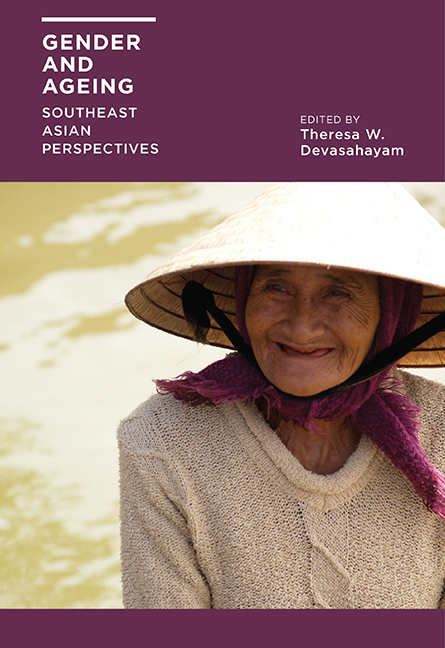Book contents
- Frontmatter
- Contents
- List of Tables and Figures
- Acknowledgments
- Contributors
- 1 Growing Old in Southeast Asia: What Do We Know about Gender?
- 2 Gender and Ageing in Thailand: A Situation Analysis of Older Women and Men
- 3 Gender and Well-being of Older Persons in Cambodia
- 4 Preparations for Old Age and Social Participation of Present and Future Older Persons in Thailand: Gender Difference
- 5 Gender and Health Status among Older Adults in Vietnam
- 6 Ageing and Gender Preferences in Rural Indonesia
- 7 Exploring the Experiences of Older Men and Women in Caregiving and Care-receiving in Sarawak, Malaysia
- 8 An “Active Ageing” Approach to Living Alone: Older Men and Women Living in Rental Flats in Singapore
- 9 Ethnic Patterns and Styles of Active Ageing among Widows and Widowers in Singapore
- 10 Employment Patterns of Older Women in Indonesia
- 11 Gender Differentials in Work and Income among Older Malaysians
- 12 Gender and Economic Well-being among Older Filipinos
- 13 Work, Retirement and the Gender Divide in the Philippines
- Index
4 - Preparations for Old Age and Social Participation of Present and Future Older Persons in Thailand: Gender Difference
Published online by Cambridge University Press: 21 October 2015
- Frontmatter
- Contents
- List of Tables and Figures
- Acknowledgments
- Contributors
- 1 Growing Old in Southeast Asia: What Do We Know about Gender?
- 2 Gender and Ageing in Thailand: A Situation Analysis of Older Women and Men
- 3 Gender and Well-being of Older Persons in Cambodia
- 4 Preparations for Old Age and Social Participation of Present and Future Older Persons in Thailand: Gender Difference
- 5 Gender and Health Status among Older Adults in Vietnam
- 6 Ageing and Gender Preferences in Rural Indonesia
- 7 Exploring the Experiences of Older Men and Women in Caregiving and Care-receiving in Sarawak, Malaysia
- 8 An “Active Ageing” Approach to Living Alone: Older Men and Women Living in Rental Flats in Singapore
- 9 Ethnic Patterns and Styles of Active Ageing among Widows and Widowers in Singapore
- 10 Employment Patterns of Older Women in Indonesia
- 11 Gender Differentials in Work and Income among Older Malaysians
- 12 Gender and Economic Well-being among Older Filipinos
- 13 Work, Retirement and the Gender Divide in the Philippines
- Index
Summary
INTRODUCTION
Rapid population ageing in many Asian countries including Thailand has led to increasing public concern about the vulnerability of the elderly. In addition, gender has been identified as a factor that might worsen the situation among older women, especially their quality of life. The processes of socialization, socio-economic development, as well as cultural setting are likely to have a cumulative impact on their life course, especially during old age. In particular, gender differences may lead to differing ability between men and women in preparing themselves for quality ageing. Insufficient or poor preparation for old age may degrade the quality of life as well as the ability of older people to contribute to society. Past studies tended to investigate the factors influencing preparation for old age, but rarely linked the preparation process with active ageing.
According to the World Health Organization, “active ageing” has been defined as the process of optimizing opportunities for health, participation and security in order to enhance quality of life as people age (World Health Organization 2002). In this sense, the word “active” refers to the ability to be physically active by participating in the labour force as well as by continuing participation in social, economic, cultural, spiritual, and civic affairs. Active participation in social activities by older persons not only increases their quality of life in terms of maintaining their autonomy, independence, and dignity, but also promotes intergenerational relationships and increases their contribution towards sustainable development in an ageing society.
This chapter presents gender differences in the preparation for old age and investigates the relationship between preparation for old age and active ageing among the present and future cohorts of male and female elderly in Thailand.
DATA SOURCES
Two sets of national surveys have been used for the analysis in this chapter. The first data set is the 2007 National Survey on Older Persons in Thailand conducted by the National Statistical Office.
- Type
- Chapter
- Information
- Gender and AgeingSoutheast Asian Perspectives, pp. 99 - 121Publisher: ISEAS–Yusof Ishak InstitutePrint publication year: 2014

